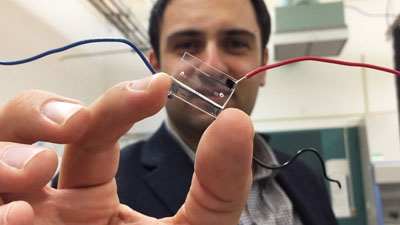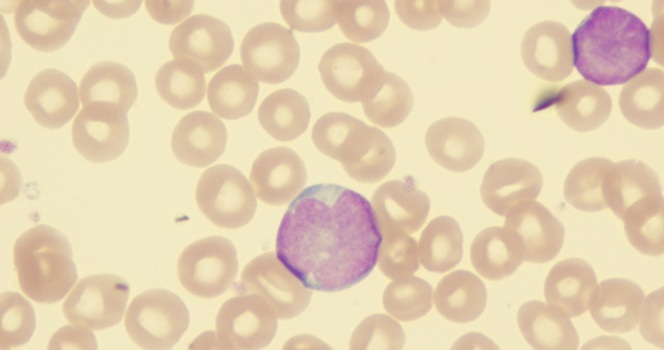Electronics-Enhanced Microfluidic Chip Counts and Characterizes Cells or Particles
|
By LabMedica International staff writers Posted on 02 May 2016 |

Image: A hybrid microfluidic chip (held by Dr. Fatih Sarioglu) uses a simple circuit pattern to assign a unique seven-bit digital identification number to each cell passing through the channels (Photo courtesy of the Georgia Institute of Technology).
In a proof-of-concept study, a team of electrical and computer engineers demonstrated the ability of an electronics-enhanced microfluidic chip to characterize and count ovarian cancer cells.
While numerous biophysical and biochemical assays have been developed that rely on spatial manipulation of particles or cells as they are processed on lab-on-a-chip devices, analysis of spatially distributed particles on these devices typically requires microscopy, which negates the cost and size advantages of microfluidic assays.
Investigators at the Georgia Institute of Technology (Atlanta, USA) have combined microfluidics with electronic sensor technology to produce a lab-on-a-chip device that can determine the location, size, and speed of cells moving through the microfluidic channels. The information for each individual cell is stored and then used as the basis for automated cell counting and analysis.
The underlying principle enabling cell identification is code division multiple access (CDMA), which is used by cellular telephone networks to separate the signals from each user. The innovative on-chip version is called microfluidic CODES. The CODES method relies on a grid of micron-scale electrical circuitry located in a layer beneath the four-channel microfluidic chip. Current flowing through the circuitry creates an electrical field in the microfluidic channels above the grid. When a cell passes through one of the microfluidic channels, it creates an impedance change in the circuitry that signals the cell’s passage and provides information about the cell’s location, size, and the speed at which it is moving through the channel. The packet of information generated for each cell is assigned a unique seven-bit identifier number that is stored for analysis.
As a proof of principle, the investigators use this technology to detect human ovarian cancer cells in four different microfluidic channels fabricated using soft lithography. In this exercise more than a thousand ovarian cancer cells were tracked with an accuracy rate of better than 90%.
“We are digitizing information about the sorting done on a microfluidic chip,” said senior author Dr. Fatih Sarioglu, assistant professor of electrical and computer engineering at the Georgia Institute of Technology. “By combining microfluidics, electronics, and telecommunications principles, we believe this will help address a significant challenge on the output side of lab-on-a-chip technology.”
“We have created an electronic sensor without any active components,” said Dr. Sarioglu. “It is just a layer of metal, cleverly patterned. The cells and the metallic layer work together to generate digital signals in the same way that cellular telephone networks keep track of each caller’s identity. We are creating the equivalent of a cell phone network on a microfluidic chip. Our technique could turn all of the microfluidic manipulations that are happening on the chip into quantitative data related to diagnostic measurements.”
The CODES-based lab-on-a-chip was described in the March 29, 2016, online edition of the journal Lab on a Chip.
Related Links:
Georgia Institute of Technology
While numerous biophysical and biochemical assays have been developed that rely on spatial manipulation of particles or cells as they are processed on lab-on-a-chip devices, analysis of spatially distributed particles on these devices typically requires microscopy, which negates the cost and size advantages of microfluidic assays.
Investigators at the Georgia Institute of Technology (Atlanta, USA) have combined microfluidics with electronic sensor technology to produce a lab-on-a-chip device that can determine the location, size, and speed of cells moving through the microfluidic channels. The information for each individual cell is stored and then used as the basis for automated cell counting and analysis.
The underlying principle enabling cell identification is code division multiple access (CDMA), which is used by cellular telephone networks to separate the signals from each user. The innovative on-chip version is called microfluidic CODES. The CODES method relies on a grid of micron-scale electrical circuitry located in a layer beneath the four-channel microfluidic chip. Current flowing through the circuitry creates an electrical field in the microfluidic channels above the grid. When a cell passes through one of the microfluidic channels, it creates an impedance change in the circuitry that signals the cell’s passage and provides information about the cell’s location, size, and the speed at which it is moving through the channel. The packet of information generated for each cell is assigned a unique seven-bit identifier number that is stored for analysis.
As a proof of principle, the investigators use this technology to detect human ovarian cancer cells in four different microfluidic channels fabricated using soft lithography. In this exercise more than a thousand ovarian cancer cells were tracked with an accuracy rate of better than 90%.
“We are digitizing information about the sorting done on a microfluidic chip,” said senior author Dr. Fatih Sarioglu, assistant professor of electrical and computer engineering at the Georgia Institute of Technology. “By combining microfluidics, electronics, and telecommunications principles, we believe this will help address a significant challenge on the output side of lab-on-a-chip technology.”
“We have created an electronic sensor without any active components,” said Dr. Sarioglu. “It is just a layer of metal, cleverly patterned. The cells and the metallic layer work together to generate digital signals in the same way that cellular telephone networks keep track of each caller’s identity. We are creating the equivalent of a cell phone network on a microfluidic chip. Our technique could turn all of the microfluidic manipulations that are happening on the chip into quantitative data related to diagnostic measurements.”
The CODES-based lab-on-a-chip was described in the March 29, 2016, online edition of the journal Lab on a Chip.
Related Links:
Georgia Institute of Technology
Latest Technology News
- Artificial Intelligence Model Could Accelerate Rare Disease Diagnosis
- AI Saliva Sensor Enables Early Detection of Head and Neck Cancer
- AI-Powered Biosensor Technology to Enable Breath Test for Lung Cancer Detection
- AI Model Achieves Breakthrough Accuracy in Ovarian Cancer Detection
- Portable Biosensor Diagnoses Psychiatric Disorders Using Saliva Samples
- Cell-Sorting Device Uses Electromagnetic Levitation to Precisely Direct Cell Movement

- Embedded GPU Platform Enables Rapid Blood Profiling for POC Diagnostics
- Viral Biosensor Test Simultaneously Detects Hepatitis and HIV
- Acoustofluidic Device to Transform Point-Of-Care sEV-Based Diagnostics
- AI Algorithm Assesses Progressive Decline in Kidney Function
Channels
Clinical Chemistry
view channel
Chemical Imaging Probe Could Track and Treat Prostate Cancer
Prostate cancer remains a leading cause of illness and death among men, with many patients eventually developing resistance to standard hormone-blocking therapies. These drugs often lose effectiveness... Read more
Mismatch Between Two Common Kidney Function Tests Indicates Serious Health Problems
Creatinine has long been the standard for measuring kidney filtration, while cystatin C — a protein produced by all human cells — has been recommended as a complementary marker because it is influenced... Read moreMolecular Diagnostics
view channel
Simple Urine Test to Revolutionize Bladder Cancer Diagnosis and Treatment
Bladder cancer is one of the most common and deadly urological cancers and is marked by a high rate of recurrence. Diagnosis and follow-up still rely heavily on invasive cystoscopy or urine cytology, which... Read more
Blood Test to Enable Earlier and Simpler Detection of Liver Fibrosis
Persistent liver damage caused by alcohol misuse or viral infections can trigger liver fibrosis, a condition in which healthy tissue is gradually replaced by collagen fibers. Even after successful treatment... Read moreHematology
view channel
Platelet Activity Blood Test in Middle Age Could Identify Early Alzheimer’s Risk
Early detection of Alzheimer’s disease remains one of the biggest unmet needs in neurology, particularly because the biological changes underlying the disorder begin decades before memory symptoms appear.... Read more
Microvesicles Measurement Could Detect Vascular Injury in Sickle Cell Disease Patients
Assessing disease severity in sickle cell disease (SCD) remains challenging, especially when trying to predict hemolysis, vascular injury, and risk of complications such as vaso-occlusive crises.... Read more
ADLM’s New Coagulation Testing Guidance to Improve Care for Patients on Blood Thinners
Direct oral anticoagulants (DOACs) are one of the most common types of blood thinners. Patients take them to prevent a host of complications that could arise from blood clotting, including stroke, deep... Read moreImmunology
view channel
New Test Distinguishes Vaccine-Induced False Positives from Active HIV Infection
Since HIV was identified in 1983, more than 91 million people have contracted the virus, and over 44 million have died from related causes. Today, nearly 40 million individuals worldwide live with HIV-1,... Read more
Gene Signature Test Predicts Response to Key Breast Cancer Treatment
DK4/6 inhibitors paired with hormone therapy have become a cornerstone treatment for advanced HR+/HER2– breast cancer, slowing tumor growth by blocking key proteins that drive cell division.... Read more
Chip Captures Cancer Cells from Blood to Help Select Right Breast Cancer Treatment
Ductal carcinoma in situ (DCIS) accounts for about a quarter of all breast cancer cases and generally carries a good prognosis. This non-invasive form of the disease may or may not become life-threatening.... Read moreMicrobiology
view channel
Rapid Diagnostic Test Matches Gold Standard for Sepsis Detection
Sepsis kills 11 million people worldwide every year and generates massive healthcare costs. In the USA and Europe alone, sepsis accounts for USD 100 billion in annual hospitalization expenses.... Read moreRapid POC Tuberculosis Test Provides Results Within 15 Minutes
Tuberculosis remains one of the world’s deadliest infectious diseases, and reducing new cases depends on identifying individuals with latent infection before it progresses. Current diagnostic tools often... Read more
Rapid Assay Identifies Bloodstream Infection Pathogens Directly from Patient Samples
Bloodstream infections in sepsis progress quickly and demand rapid, precise diagnosis. Current blood-culture methods often take one to five days to identify the pathogen, leaving clinicians to treat blindly... Read morePathology
view channel
Tunable Cell-Sorting Device Holds Potential for Multiple Biomedical Applications
Isolating rare cancer cells from blood is essential for diagnosing metastasis and guiding treatment decisions, but remains technically challenging. Many existing techniques struggle to balance accuracy,... Read moreAI Tool Outperforms Doctors in Spotting Blood Cell Abnormalities
Diagnosing blood disorders depends on recognizing subtle abnormalities in cell size, shape, and structure, yet this process is slow, subjective, and requires years of expert training. Even specialists... Read moreIndustry
view channel
Abbott Acquires Cancer-Screening Company Exact Sciences
Abbott (Abbott Park, IL, USA) has entered into a definitive agreement to acquire Exact Sciences (Madison, WI, USA), enabling it to enter and lead in fast-growing cancer diagnostics segments.... Read more






















